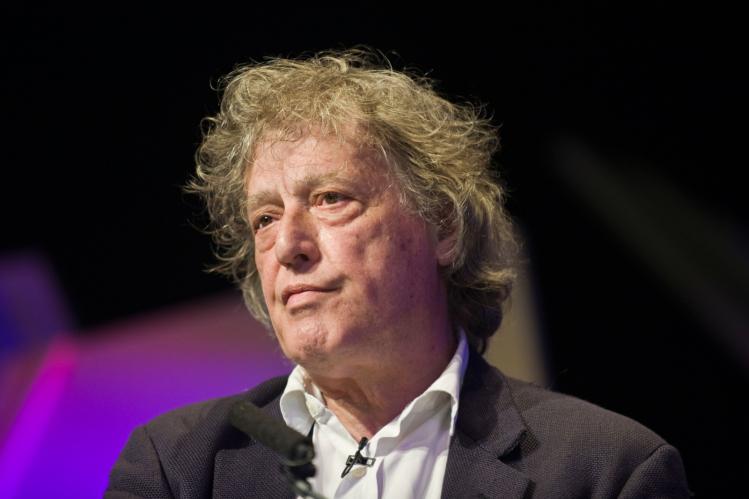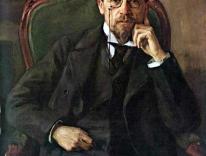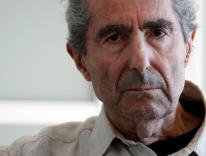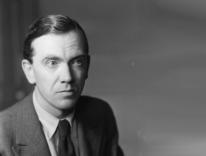
A dotty academic with a grand project (he hopes “to set British moral philosophy back forty years, which is roughly when it went off the rails”) tries to describe his profession to a detective named Bones: “Yes, I’m something of a logician myself.” Bones answers, “Really? Sawing ladies in half, that sort of thing?”
A precocious thirteen-year-old girl asks her tutor, “Septimus, what is carnal embrace?” The sharp twenty-two-year-old Septimus responds, “Carnal embrace is the practice of throwing one’s arms around a side of beef.”
Three students are punting together at Oxford in the 1870s. One of them, a future bibliographer, tries his hand at translating Catullus: “Let us live, my Lesbia, and let us love, and value at one penny the murmurs of disapproving old men.” Another, the future poet and classicist A. E. Housman, finishes things off: “And not give two tuppence for the mutterance of old men’s tutt-tutterence.”
These three exchanges, from Jumpers (1972), Arcadia (1993), and The Invention of Love (1997), couldn’t have come from anywhere but a Tom Stoppard play. Each hits the distinct Stoppardian note: characters comically talking past and over and beside one another, the high (Latin verse) shaking hands and dancing with the low (“tutt-tutterence”). Confusion prevails: sex is mixed up with beef, logicians mistaken as magicians. (In the end, though, are they really so different?) Stoppard’s playfulness doesn’t shy away from learning; you have to know, or at least half-know, the etymology of “carnal” in order to get the joke from Arcadia. His narratives tend to center on lecture-worthy topics: the nature of consciousness or the implications of chaos theory; the responsibility of the artist or the perfidy of the scholar. And yet, somehow, always, they entertain. As Hermione Lee puts it in Tom Stoppard: A Life (Knopf, $37.50, 896 pp.), Stoppard is “a playwright of ideas who also want[s] his audiences to love him.” Over the course of his long career, Stoppard has banked on the fact that ideas and love aren’t antithetical; that, as Lee puts it, “finding things out is as exciting as sex…and can be as misdirected and chaotic”; that audiences can take in, even love, a “difficult” play if it fizzes and pops.
No one does literary biography better than Hermione Lee. Her 1996 biography of Virginia Woolf remains the best single-volume book on the novelist; her 2013 Penelope Fitzgerald: A Life is just as good. Lee’s books offer tasty morsels of research: for instance, that among Fitzgerald’s pupils at a British cramming school were Edward St. Aubyn and Helena Bonham Carter. Being a great researcher, though, is necessary but not sufficient for being a great literary biographer. You don’t read a biography of Woolf because you care about her life; you care about her life because you care about her work. The biographer must have a sense for her subject’s style: the style of her writing, the particular way that her sentences hold together and move; the style of her life, the particular way that she holds herself together in private and in company; and the way these two styles refract one another. Lee’s books run long. Her biography of Edith Wharton is over nine hundred pages, as is her book on Woolf, as is her new one on Stoppard. That’s because she takes time to slow down and offer sensitive readings, mini-essays really, on individual works and characters. Newland Archer from Wharton’s The Age of Innocence “is always breaking out in a kind of disassociated demonic hollow laughter at the performance he is engaged in, like a spectator at the play of his own life”; Woolf’s To the Lighthouse is “about something ending, and it contains a number of endings”; Stoppard’s Arcadia takes time as its subject: “What is happening to it; how we live in it, not knowing our fates; whether those things which have become ‘lost to view will have their time again.’”
Over her career, Lee has chosen superb writers who have also lived superbly interesting lives. (To take one example, Fitzgerald lived on a Thames houseboat that sank, taking with it all of her family’s possessions.) Stoppard is no exception. Born Tomáš Straussler in 1937 to Jewish parents, he escaped from Czechoslovakia to Singapore to India to England, his father dying en route. After his mother remarried, he took the last name of his British stepfather. By his own account, Stoppard’s life has been stalked by luck. He got out of Europe at just the right time; he landed an early job as a journalist, for which he wasn’t particularly qualified and which introduced him to the kind of frenetic and contained research that would pay off in his playwriting; his first huge hit, Rosencrantz and Guildenstern Are Dead (1966), premiered when audiences were primed for existential absurdism. (“I didn’t know what the word ‘existential’ meant until it was applied to Rosencrantz,” he has claimed unconvincingly.) He’s given lectures across the globe, dined with Margaret Thatcher (he considered that a stroke of luck; his writerly friends did not), and become close to Mick Jagger, Harold Pinter, John le Carré, and many others. This is all catnip to the biographer, as is Stoppard’s brilliance in several different forms (radio plays, television, film) and the money he has made and spent. Starting in 1997, he has thrown a biannual party at the Physic Garden near Chelsea Harbour in London, complete with “jugglers, and stilt-walkers dressed as flamingoes or clowns.” There’s expensive food and drink and a fancy guest list; Yoko Ono and Sting have attended. His 2013 party cost around £118,000. As Lee writes, “One cynical publishing friend thought he must have been wondering what to do with all his money.”
This might make Stoppard sound unlikeable. He’s not. “I’ve often asked people to sum him up with three words,” Lee writes. “They come up with: brainy, inspirational, passionate, rigorous, sympathetic, conservative with a small ‘c,’ irresistible, supportive, witty, curious, open.” The list goes on. His life has been charmed; his personality is charming. He’s a remarkably loyal friend: “He never forgot birthdays; he always gave thoughtful first-night presents to the cast and company; he would always remember his agents and his publishers at Christmas; he gave loans to anyone he knew who was in need; he responded to appeals from strangers with a good cause.” Stoppard’s most lasting literary love is Hemingway (he loves the “tensile quality” of his prose); his absurdism sometimes brings about comparisons to Beckett. But, while reading Lee’s biography, I kept thinking of Auden—similarly generous, similarly brilliant as a craftsman, similarly unafraid of burdening his lissome language with the heft of ideas.
Writing on Stoppard presents Lee with two primary challenges. First, he’s a playwright, where she previously has worked on novelists. Second, he’s living, where her previous subjects have been, convenient for a biographer, dead (with one exception, her 1982 Philip Roth—less a biography than a critical study). Both of these difficulties have to do with, in one way or another, the problem of other people. Playwrights work collaboratively, their plays belonging as much to the directors, actors, and set designers as to themselves; living people have friends who might not be as forthcoming as the biographer would like. Lee addresses these obstacles head on. Because Stoppard is still alive, and because Lee is his authorized biographer, she gets to be in the room and see how he works with others. She brings us into the rehearsal space, where Stoppard “makes a writer’s nest of his corner table, listening hard, editing the layout of the programme, texting, reading the papers, occasionally snoozing, taking pencils out of his zip-up pencil case, ferreting in his beautiful old soft leather shoulder bag, cracking peanuts, clipping his nails and eating bananas (and diabetic sweets).” We learn how he revises up through his shows’ previews, cutting and tweaking “always in the interests of clarity and speed.” We read about his friendship with the director Mike Nichols, his negotiations with various directors and producers, his complicated dynamics with Sean Connery. In 1989, Stoppard wrote the screenplay for The Russia House, a novel by the late le Carré, whose real name was David Cornwell. Cornwell and Stoppard brought the script to Connery’s hotel room:
They sat on the sofa while Connery turned the pages of the script, saying “too long, too long.” According to Cornwell, Connery expostulated, of one speech in the script: “If anybody said all of that to me, I’d kick him the balls!” As they were leaving, Stoppard turned to Cornwell and said, “I think I shall have to find a new typeface for irony.” Cornwell didn’t know if Connery had heard him.
Stoppard has worked on a surprising number of films. Most famously, he wrote the screenplay for Shakespeare in Love, for which he won an Oscar. But he also has punched up the dialogue for Indiana Jones and the Last Crusade and worked on less classic films like Mom, “in which a Los Angeles mother turns into a werewolf,” and 102 Dalmatians. “One of the lines of his which survived in the movie,” Lee writes, “and which he and [Glenn] Close particularly liked, was ‘You may have won the battle, but I’m about to win the wardrobe.’” He offered candid notes on Robin Hood, starring Russell Crowe: “For the forest gods’ sake will you save this fuck-up!”
Stoppard has created permanent works of art. As Lee correctly asserts, Arcadia “will last as long as there are actors and theatres.” He also worked on the 1992 doggy comedy, Beethoven. Why? Partly for the paycheck, undoubtedly; those parties won’t pay for themselves. But also because, again like Auden, Stoppard likes to see a thing made well, even if that thing is schlock. “I think it’s right to take pride in one’s craftsmanship as much as one’s originality,” he’s said. There’s a philosophical seriousness, a metaphysical yearning, to Stoppard’s best plays. Asked if he believed in God, he responded, “Well, I keep looking over my shoulder. When I am asked whether I believe in God, my answer is that I don’t know what the question means. I approve of belief in God and I try to behave as if there is one, but that hardly amounts to faith.” That answer reveals a tendency in Stoppard. It’s not exactly that he refuses to take sides in an argument—belief or disbelief, high or low. It’s that he’s convinced by different sides at different times.
Lee ends by ruminating on what it means to write the life of someone whose life isn’t yet over. “How is this to end?” she asks. “You cannot end the written life of a living subject. Nor can you ever tell the whole story.” Right before the pandemic hit, Stoppard’s latest play, Leopoldstadt, premiered. It received good reviews; then it, with everything else, shut down. That’s one kind of ending. In her conclusion, Lee channels Auden’s great elegy for W. B. Yeats:
But in the end, this person, Tom Stoppard, will vanish into the darkness.... He will live on in his work: you will find him there, as he has always wanted you to. Once he vanishes, he becomes his admirers. His life turns into the work he has left behind, and into other people’s stories, legends, anecdotes and versions of him—of which this book is one.
Please email comments to [email protected] and join the conversation on our Facebook page.
Previous Story
The Antics of the Turnips
Next Story
Going Big


